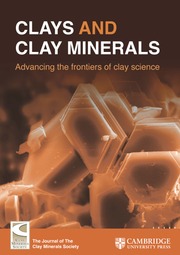Article contents
Structure of Some Allophanes from New Zealand
Published online by Cambridge University Press: 01 July 2024
Abstract
Allophane samples from soils, pumice, and stream beds have been studied by electron optical, infrared absorption, X-ray fluorescence, gas chromatography, and phosphate adsorption methods. The allophane particles were hollow spherules or polyhedra 35 and 50 Å in diameter with molar Al/Si ratios close to 2.0. The thickness of the wall of the spherules was estimated to be 7 Å. For the pumice allophanes, the wall was largely composed of imogolite structural units (OH)3Al2O3SiOH. Defects or pores were present in the wall and probably were the sites where phosphate was adsorbed. It is suggested that these allophanes with molar Al/Si ratios close to 2.0 should be called “proto-imogolite” allophane.
Two soil allophanes had a similar structure to the allophane from Stratford pumice, but small amounts of layer silicates, including halloysite, were also present in the soil samples, as indicated by infrared bands at 470, 1030, and 1100 cm−1. The allophane from the stream bed at Silica Springs had an infrared spectrum similar to feldspathoids, and it did not have the imogolite structure.
Резюме
Образцы аллофана из почь, пемзы, и русел рек изучались методами электронной оптики, инфракрасной адсорбции, рентгеновской флуоресценции, газовой хроматографии, и фосфатной адсорбции. Аллофанновые частицы представляли собой полые сферы или многогранники с диаметрами 35 и 50 Å и молярными отношениями Al/Si, близкими к 2,0. Было установлено, что толщина стенок сфер пемзовых аллофанов равна 7,0 Å. Стенки в основном составлены из имого-литовных структурных элементов (OH)3Al2O3SiOH. B стенках наблюдались дефекты или поры, которые вероятно служили местами адсорбции фосфатов. Предполагается, что эти аллофаны с молярными отношениями Al/Si, близкими к 2,0, должны называться «прото-имоголитовые» аллофаны.
Два почвенных аллофана имеют сходную структуру с аллофаном из Стратфордской пемзы, но небольшие количества слойных силикатов, включая галлуазиты, также присутствовали в почвенных образцах, что определяется инфракрасными полосами при 470, 1030, и 1100 см−1. Аллофан из русла потока в Силика Спрингс имел инфракрасный спектр, подобный спектру фельдшпатойдов, и не имел имоголитовой структуры. [N.R.]
Resümee
Allophanproben aus Böden, Bims, und Flußbetten wurden mittels Elektronenoptik, Infrarotabsorption, Röntgenfluoreszenz, Gaschromatographie, und Phosphatadsorptionsmethoden untersucht. Die Allophanteilchen waren hohle Kügelchen oder Polyeder mit Durchmessern von 35–50 Å und einem molaren Al/Si-Verhältnis nahe 2,0. Die Dicke der Kugelwand wurde bei den Allophanen aus Bims auf etwa 7 Å geschätzt, wobei die Wand hauptsächlich aus Einheiten mit Imogolitstruktur (OH)3Al2O3SiOH bestand. Fehler oder Poren traten in den Wänden auf und waren wahrscheinlich die Stellen, wo Phosphat adsorbiert wurde. Es wird vorgeschlagen, diese Allophane mit molaren Al/Si-Verhältnissen nahe 2,0 als “Proto-Imogolit” Allophane zu bezeichnen.
Zwei Allophane aus Böden hatten eine Struktur ähnlich den Allophanen aus dem Stratford Bims, aber geringe Mengen von Schichtsilikaten einschließlich Halloysit waren in den Bodenproben enthalten, wie die Infrarotbanden bei 470, 1030, und 1100 cm−1 zeigen. Der Allophan aus dem Flußbett bei Silica Springs hatte ein Infrarotspektrum ähnlich dem von Feldspatvertretern und zeigte keine Imogolitstruktur. [U.W.]
Résumé
Des échantillons d'allophane de sols, de pierre ponce, et de lits de ruisseaux ont été étudiés par des méthodes optiques à électrons, d'adsorption infrarouge, de fluorescence aux rayons-X, de chromatographic de gaz, et d'adsorption de phosphate. Les particules d'allophane sont des sphérules creuses ou des polyèdres de 35 et 50 Å de diamètre avec des proportions molaires Al/Si près de 2,0. L’épaisseur de la paroi des sphérules était estimée être 7 Å, pour les allophanes de pierre ponce, la paroi était en grande partie formée d'unités structurales d'imogolite (OH)3Al2O3SiOH. Des défauts ou des pores étaient présents dans la paroi et étaient probablement les sites d'adsorption de phosphate. On a suggéré que les allophanes avec des proportions molaires Al/Si près de 2,0 soient appellées allophanes “proto-imogolite.”
Deux allophanes du sol avaient une structure semblable à l'allophane de la pierre ponce de Stratford, mais de petites quantités de silicates de couches comprenant de l'halloysite étaient aussi présentes dan les échantillons du sol, indiquées par les bandes infrarouges à 470, 1030, et 1100 cm−1. L'allophane du lit de ruisseau à Silica Springs avait un spectre infrarouge semblable à celui des feldspathoides, et n'avait pas la structure de l'imogolite. [D.J.]
- Type
- Research Article
- Information
- Copyright
- Copyright © Clay Minerals Society 1980
References
- 115
- Cited by


